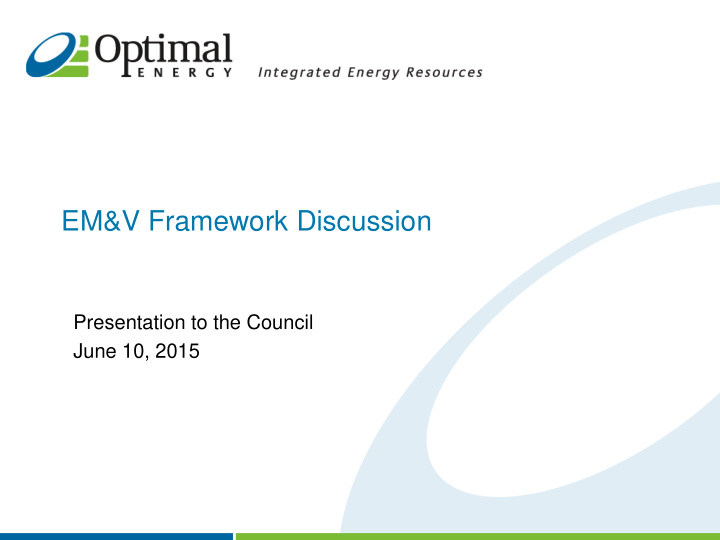



EM&V Framework Discussion Presentation to the Council June 10, 2015
Issues for Discussion Investing EM&V Collaborative with Responsibility Basing Achievement on Ex-post Verified Net Savings Assessing Cost-Effectiveness using TRC Using the Mid-Atlantic TRM 2
Investing EM&V Collaborative with Responsibility EM&V Collaborative – Issues RFP for IEC(s); establishes multi-year evaluation plan and budget; discusses and approves individual study plans, work products, and reports DNREC – Promulgates regulations; hires and manages EEAC Consultant EEAC Consultants – Reviews and approves selection of IECs; oversees planning of EM&V activities AEPs/PAs – Contracts with IECs; tracks and provides data; identifies EM&V needs Independent Evaluation Contractor(s) – completes all primary EM&V activities 3
Basing Achievement on Ex-post Verified Net Savings Gross savings determined by best available method Net savings calculated using pre-determined NTG ratios, prospectively Changes to TRM are prospective, covered in annual update 4
Assessing Cost-Effectiveness using TRC Captures full effective useful life of measures, discounting at societal rate Benefits – All avoided energy and capacity benefits – DRIPE – Non-energy benefits (quantifiable and/or adder) Costs – Program administration costs – Incremental measure costs (up to and including labor as appropriate) – Non-energy costs (quantifiable and/or adder) 5
Using the Mid-Atlantic TRM Whenever Possible Use enhancements, expansions, or local factors when necessary Suggest expansions, etc. to NEEP for inclusion in next version 6
Cost Recovery and Performance Incentives Caveat: for those AEPs that are regulated by the PSC, cost recovery and performance incentives are the purview of the Commission Three key components – Recover program costs Lost Net – Address lost net revenues Revenue Cost – Provide incentives (evaluators need to Recovery recommend measurable metrics) Performance Incentive Utility “made whole” 7
Collect 100% of Actual Program Costs Strive for proportional allocation of costs by customer class, except for low income Amortizing program costs to better align with program benefits has merit, but interest rate likely < WACC Annual true-up of under/over-collection Program costs NOT included in rate-base 8
Remove Dis-incentives for Efficiency Decoupling is a possibility Lost revenue adjustments should NOT be made in isolation; AEPs should not earn above actual net lost revenue – Example: Verified efficiency savings of 1,00 MWh, but AEP only 350 MWh short (e.g., hot summer, economic expansion) Annual true-up 9
Provide Positive Incentives Give EE/DR similar earnings potential as supply-side investments Protect ratepayers against excessive awards Based on measureable performance under the AEP’s control Tied to outcomes (e.g., verified savings, market transformation, cost of savings) rather than actions (e.g., expenditures, meetings, events) Scalable, multi-variate, and multi-year 10
Jeff Loiter Optimal Energy, Inc. 10600 Route 116, Suite 3 Hinesburg, VT 05461 802-482-5600
Recommend
More recommend